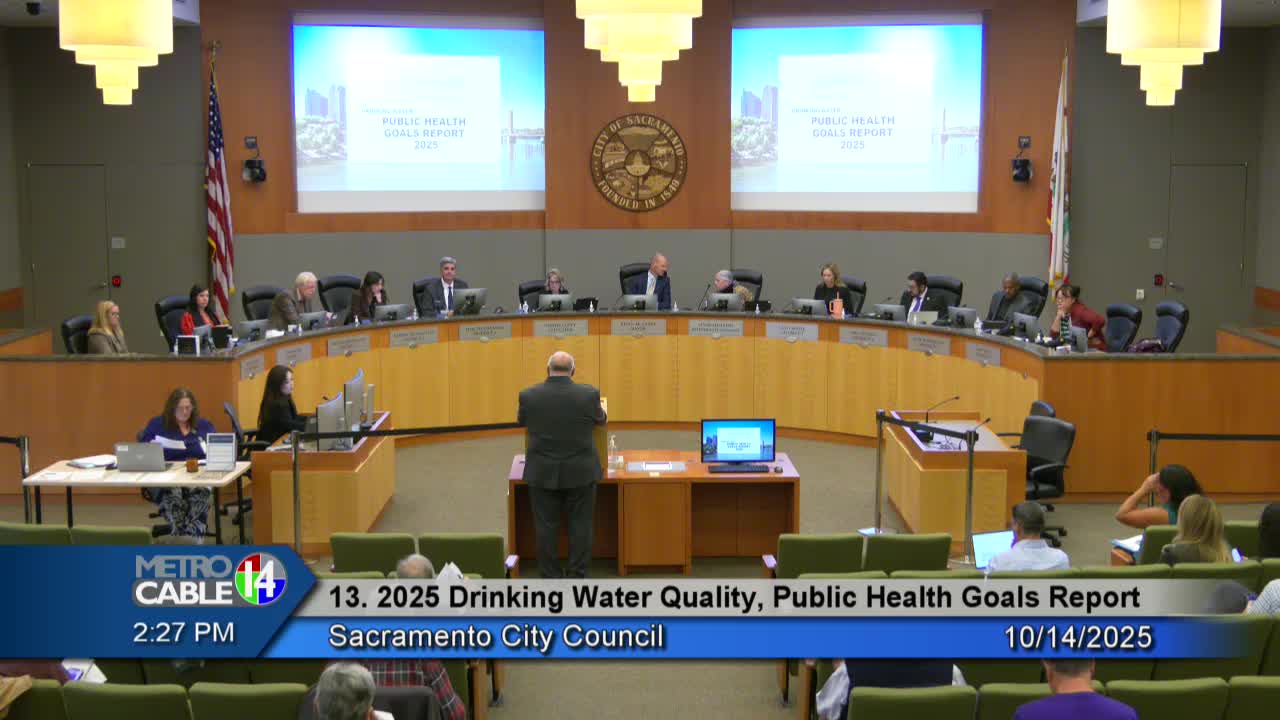Council accepts 2025 drinking water public health goals report; city says state public-health goals exceeded in limited groundwater sources
October 14, 2025 | Sacramento , Sacramento County, California
This article was created by AI summarizing key points discussed. AI makes mistakes, so for full details and context, please refer to the video of the full meeting. Please report any errors so we can fix them. Report an error »

The City Council voted to accept the Department of Utilities' 2025 public health goals report for drinking water, a required triennial evaluation comparing Sacramento's water quality to non-binding public health goals set by the state of California. Mark Severyd, the city's water quality superintendent, told council the city's system meets or surpasses all legally enforceable federal and state standards.
The 2025 report identifies five contaminants detected above California's public health goals in some water sources: arsenic, hexavalent chromium, radionuclides and two PFAS compounds (PFOA and PFOS). Severyd stressed the detections were limited to groundwater sources, which supply about 20% of the city's drinking water; surface water, which comprises roughly 80% of the city's supply, was not affected.
Why it matters: public health goals are health-based targets the state sets without consideration of technical or economic feasibility. They differ from maximum contaminant levels, which are legally enforceable. Severyd told council the city's water currently meets enforceable standards and that bringing water down to these voluntary public health goals would likely require significant additional treatment capacity and cost without a guaranteed public-health benefit at the system level.
Council discussion and next steps: Council member Kaplan asked that future reports include clear historical context showing trends so readers can see whether contaminant levels are stable, improving or worsening over time. Severyd said the contaminants and their extent were unchanged from the 2022 report and described current operational responses: keeping impacted groundwater wells offline where practical, developing replacement well sites and participating in statewide and national water-quality working groups.
The council voted to accept the report. The action does not require new treatment or capital projects at this time; staff said they remain available to brief council further and to provide more detailed, geography-specific tracing of where groundwater-derived water is delivered in the distribution system as a follow-up.
Ending: The acceptance moves the report into the public record. Staff emphasized monitoring will continue and that any future recommendation to add treatment processes would be presented with cost estimates and a clear explanation of benefits and tradeoffs.
The 2025 report identifies five contaminants detected above California's public health goals in some water sources: arsenic, hexavalent chromium, radionuclides and two PFAS compounds (PFOA and PFOS). Severyd stressed the detections were limited to groundwater sources, which supply about 20% of the city's drinking water; surface water, which comprises roughly 80% of the city's supply, was not affected.
Why it matters: public health goals are health-based targets the state sets without consideration of technical or economic feasibility. They differ from maximum contaminant levels, which are legally enforceable. Severyd told council the city's water currently meets enforceable standards and that bringing water down to these voluntary public health goals would likely require significant additional treatment capacity and cost without a guaranteed public-health benefit at the system level.
Council discussion and next steps: Council member Kaplan asked that future reports include clear historical context showing trends so readers can see whether contaminant levels are stable, improving or worsening over time. Severyd said the contaminants and their extent were unchanged from the 2022 report and described current operational responses: keeping impacted groundwater wells offline where practical, developing replacement well sites and participating in statewide and national water-quality working groups.
The council voted to accept the report. The action does not require new treatment or capital projects at this time; staff said they remain available to brief council further and to provide more detailed, geography-specific tracing of where groundwater-derived water is delivered in the distribution system as a follow-up.
Ending: The acceptance moves the report into the public record. Staff emphasized monitoring will continue and that any future recommendation to add treatment processes would be presented with cost estimates and a clear explanation of benefits and tradeoffs.
View the Full Meeting & All Its Details
This article offers just a summary. Unlock complete video, transcripts, and insights as a Founder Member.
✓
Watch full, unedited meeting videos
✓
Search every word spoken in unlimited transcripts
✓
AI summaries & real-time alerts (all government levels)
✓
Permanent access to expanding government content
30-day money-back guarantee

